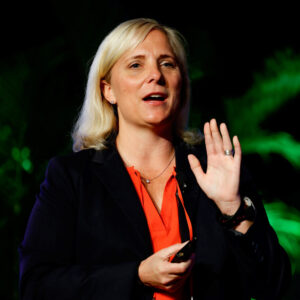A palpable sense of excitement filled the air on the final day of ACRP’s 2022 conference in Orlando. It was as if attendees couldn’t wait to see what new ideas and technologies are waiting just around the corner to help them further raise the bar and continue to deliver vital drugs and treatments to enhance human life.
Clinical trial professionals will have a strong hand in determining their own future, speakers emphasized. “Your voices are important,” Jeanne Taylor Hecht, CEO, JTH Consulting & Associates, told attendees.
In that spirit, ACRP Board of Trustees member Christina Brennan, vice president, clinical research at Northwell Health, issued a challenge to attendees. “It doesn’t end today, what will you do to make your mark in clinical research when you leave here?”
“Without you, there is no clinical research,” said ACRP Board of Trustees member, Elisa Cascade, Chief Product Officer, Science 37. Cascade was one of many expressing enthusiasm about how hybrid and decentralized clinical trials (DCTs) are “bringing trials to patients, speeding up recruitment, retention, and improving diversity.
Elisa Hurley, PhD, Executive Director, Public Responsibility in Medicine and Research (PRIM&R), agreed about DCT’s positive impact on diversity. “I’m hopeful these technologies do have the potential to bring more trials to where people are,” she said.
Noting hybrid and DCTs are “here to stay,” Isaac R. Rodriguez-Chavez, PhD, MHSc, MSc, Senior Vice President, Scientific and Clinical Affairs, Drug Development Services, Head, Strategy Center for Decentralized Clinical Trials and Digital Medicine, ICON, stressed the clinical trial industry needs to be increasingly “nimble, and embrace digitization at all levels.” He’s a big champion of increased hybrid and DCT use in part because it will “lower the burden to participants” and improve clinical trial diversity.
And while much of the discussion centered on the benefits of innovative technologies and DCTs, several speakers reminded the audience not to forget the human factor.
“Diverse patients don’t want to be accessed, they want to have access,” said Dawn Furey, Chief Clinical Operations Officer, Circuit Clinical. She’s a firm believer in the power of human connections as the foundation for successful change.
“Technology is great, but at end of the day it is human beings who need to engage with real humans for blood draws” and other regular trial procedures, Furey said. For DCTs and hybrid variations to work effectively, a stream or robust and shared feedback between sponsors, sites, and patients is vital. “We can’t forget the human connection,” Furey stressed.
“The reality is today you are doing the work more than once because technologies don’t talk to each other,” Cascade said. I’d love to see us be able to enter data once and see it go across systems,” she said, stressing technology will only succeed on a wide scale if it meets the challenge. Among other suggestions, Cascade called on technology providers to seek feedback from users and find ways to reduce redundancy.
Hurley also called on industry to harness the general public’s renewed interest in the clinical trial industry because of the Covid-19 pandemic. “It’s an opportunity to reset relationships and earn the public’s trust,” she said. Technology can help, she suggested, because it can make it easier for sponsors and others to be transparent and share trial results. “Returning results back to [trial] participants are a huge part of improving trust,” she said.
And don’t forget to factor in the influx of new entrants to the workforce when contemplating the future, speakers said.
“New workforce entrants embrace technology,” said Leslie Wolfe, BS, MHA, Director, Clinical Research- Early Talent Development & Clinical Trial Coordinator Organization, Global Clinical Trial Operations, Merck. “They are used to changes happening rapidly. New talent is excited and wants to be part of the change,” she said.
Wolfe advocated more two-way mentorships, where the experienced professional brings expertise and historical knowledge to the table, while the younger professional brings an openness to new ideas and other attributes. “New entrants don’t have any mental constraints about how it’s been done in the past,” Wolfe said.
“We need to capitalize” on the potential synergy between different generations and harness it to enjoy the best of both approaches, she said. “Mentorship and reverse mentorships are going to be really important in the future,” she added.
Hecht echoed Wolfe’s sentiments, telling attendees how “refreshed” she is every time she gets the opportunity to work with students and other young people. “I learn so much,” she said.
Author: Michael Causey



